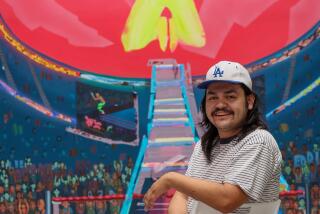ART : Candid Camera of Photorealist Painter Estes
Most of us think of something recent as an event that happened just a short time ago--last year, or last month, or last week. But the folks at the Orange Coast College Art Gallery must be setting their clocks according to Ice Age Time.
“Richard Estes: Recent Work,” at the gallery through May 10, turns out to be a group of prints by the Photorealist painter that date from the 1970s and early ‘80s. When Estes started out painting his cool, meticulously detailed urban scenes in the late 1960s, he was riding the crest of a brief vogue for painting sharply focused images based on photographs. Since then, painting has moved on to investigate other styles and attitudes. Photorealism now seems as dated as Op and Pop Art.
But Estes’ work has filled a certain niche, satisfying people who like their pictures “realistic” and also viewers fascinated by the special twist Estes has given the traditional genre of cityscape--the subject of such diverse artists of the past as Antonio Canaletto, Maurice Utrillo and Edward Hopper.
It is disappointing that the works on view are screen prints--made from Estes’ designs by a printer pushing ink through a separate screen for each block of color--rather than the artist’s virtuoso paintings. But his pristine, carefully ordered vision remains the same: empty streets and crisp expanses of glass reflecting an impersonal bustle of building styles, billboards and shop signs. A brisk blue sky is the inevitable sign of perfect weather, and there’s not a single human being in sight.
Estes based these works on photographs--a working method he learned during the years he worked for an ad agency, when someone in the office would pose for a Polaroid shot of, say, hands wrapping a package, so he could draw it in a hurry. In fact, the almost preternaturally still, uneventful quality of the scenes has partly to do with the fact that Estes did his photographing on Sunday mornings, when less traffic was liable to get in the way of the storefronts.
In a 1977 interview, he explained that he aimed to make all the parts of a painting “of equal interest and importance,” which is not the way we normally look at the world. Our gaze is selective; we focus on one thing and ignore another.
Estes, on the other hand, takes advantage of the reflective properties of glass to load his canvases with reflections of objects (advertising signs on a passing bus, fragments of buildings) that are actually on or across the street-- behind the viewer. At the same time, he offers a detailed view of the surface of the building and usually allows a selective peek inside the building.
Photographs--Estes always used several for each painting--nailed down the myriad details of a scene much more efficiently than his own eye could see them. The photographs became raw material from which he could add or subtract detail and sharpen up the geometric organization of the canvas. His ability to organize, rather than just transcribe, detail sets him apart from a run-of-the-mill realist.
Painting, he told his interviewer, is “trickery because you can make people respond by guiding their eyes around the picture. The photograph doesn’t do that because a camera doesn’t have ideas. It can only reproduce.”
And yet, the notion of a neutral, camera-like observer clearly appealed to this die-hard traditionalist who claimed he never cared for Abstract Expressionism or even Picasso or Matisse.
“The great artists of the past never let their feelings or personalities intrude that much,” Estes said. Although he started out putting figures in his paintings, he never used them after 1970. Why? Because “people start relating to the figures, and it’s an emotional relationship . . . . Without the figure, it’s more purely a visual experience.”
Oddly, the exhibit offers no biographical information about the artist, who was born in 1936 in Keewane, Ill., and studied at the Art Institute of Chicago. He moved to New York when he was in his early 20s. After a few years of working at day jobs as a commercial artist (the occupation of several Pop-artists-to-be), he saved up a few thousand dollars so he could take a couple of years off and just paint. In 1968 he had his first solo show and soon made a tidy living from his art. Critical acclaim, however, largely eluded him at a time when realism was discredited in favor of Pop and Color Field painting.
The curious thing about his New York City views--which predominate in this show--is that they don’t reflect the slightest hint of the city’s late 20th-Century woes--homelessness, drug abuse and the growing gap between rich and poor. No matter whether Estes painted slick office buildings or views down seedier streets, the human pulse of the city is invisible. There’s never any garbage in the streets, and even the graffiti on a subway car (in a 1981 painting) is muted into unreadable patches of bland color.
Neither down-and-dirty journalistic reportage nor fancifully idealized visions of urban life, these city views occupy a curious limbo of the imagination. An observer from the 21st Century could date them only by knowing when a small shopkeeper occupied a particular site, or by tracking down the dates of an advertising campaign reflected in a window.
What: “Richard Estes: Recent Work.”
When: 10 a.m. to 2 p.m. Monday through Friday, through May 10.
Where: Orange Coast College Art Gallery, 2701 Fairview Road, Costa Mesa.
Whereabouts: Take San Diego Freeway to Fairview Road; drive south and turn right at Arlington Drive to park. Gallery is behind the Arts Center.
Wherewithal: Admission is free.
Where to Call: (714) 432-5039.
More to Read
The biggest entertainment stories
Get our big stories about Hollywood, film, television, music, arts, culture and more right in your inbox as soon as they publish.
You may occasionally receive promotional content from the Los Angeles Times.










